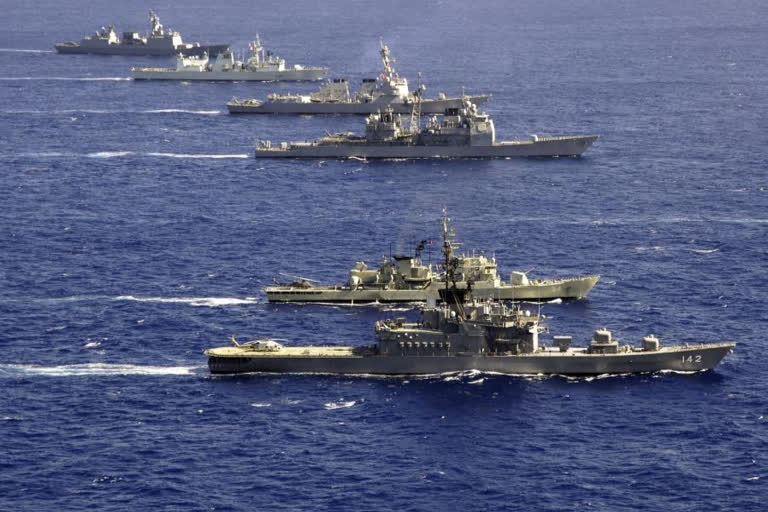New Delhi: India will be part of a group of 26 countries whose navies and land forces will embark on one of the world’s biggest international maritime exercises till date in the waters of the Pacific Ocean stretching from the California seaboard to the tropical island of Hawaii from June 29-August 4, 2022. Already being a member of the ‘Quadrilateral Security Dialogue’ or ‘Quad’ and as an active participant of the US-hosted biennial month-long “Rim of the Pacific” exercise, or RIMPAC 2022, India is sending out a clear signal to China with whom it is engaged in a major border showdown in eastern Ladakh since May 2020.
Announcing RIMPAC 2022, the US Navy’s 3rd Fleet has said in a release: “Twenty-six nations, 38 surface ships, four submarines, nine national land forces, more than 170 aircraft and approximately 25,000 personnel will participate in the biennial RIMPAC exercise scheduled June 29 to Aug. 4, in and around the Hawaiian Islands and Southern California.”
Besides India and host US, the countries that will participate are Australia, Brunei, Canada, Chile, Colombia, Denmark, Ecuador, France, Germany, Indonesia, Israel, Japan, Malaysia, Mexico, Netherlands, New Zealand, Peru, the Republic of Korea, the Republic of the Philippines, Singapore, Sri Lanka, Thailand, Tonga, and UK. India’s relationship with the US-led western block is a complicated one where in pursuance of its stated policy of ‘strategic autonomy’, it positions itself alongside the west in standing up to China but steers clear of a clear position when it comes to categorical condemnation of Russia on the military action in Ukraine that began on February 24.
Ironically, the Ukraine conflict has also clubbed India and China together in a small clique of countries that have refused to unconditionally condemn Russia. The US-China relationship has also come to a head with President Joe Biden, in a departure from US’ declared ‘One China’ and ‘strategic ambiguity' policies, committed to come to Taiwan’s aid if Chinese military launches an invasion.
On May 23, Biden had replied to a question if the US would defend Taiwan militarily if China invaded: “Yes... that’s the commitment we made… The idea that it (Taiwan) can be taken by force... is just not appropriate. It will dislocate the entire region and be another action similar to what happened in Ukraine.”
To be fair to India, the US has not adopted a similar supportive posture towards India in case of a Chinese attack. But at the same time, the US is very keen to enlist India’s support against the emerging Russia-China axis with Russia also trying to woo India based on a legacy relationship of close military relationship.
Besides being a growing military power, the world’s second-most populated country with a huge and growing market, India’s economy grew at its fastest in 22 years when it registered 8.7% GDP growth in 2021-22 according to data released by the National Statistical Office (NSO) on Sunday.
The IMF has also projected that India may become the world’s fastest growing major economy in 2022 with a growth rate of higher than 8 percent.
The US Navy statement adds: “During RIMPAC, a network of capable, adaptive partners train and operate together in order to strengthen their collective forces and promote a free and open Indo-Pacific. RIMPAC 2022 contributes to the increased interoperability, resiliency and agility needed by the Joint and Combined Force to deter and defeat aggression by major powers across all domains and levels of conflict.”
While Denmark and Ecuador have joined for the 28th edition of the exercise that began in 1971, Vietnam has opted out from the 2018 edition. RIMPAC 2020—because of COVID—was scaled down to include only 10 nations, 22 ships, one submarine, and about 5,300 personnel when it was held near Hawaii from August 17 to 31, 2020.
India first participated in RIMPAC in 2014 when it sent the INS Sahyadri, an indigenously built Shivalik Class stealth multirole frigate. In 2016, it deployed the INS Satpura for the event. In 2018, it was again the INS Sahyadri. Before 2014, the Indian Navy was an observer for the 2006, 2010 and 2012 editions of the exercise. First begun in 1971 as an annual exercise by the US, Australia, and Canada, from 1974, it became a biennial event. Interestingly, China was part of the 2014 and 2016 editions of RIMPAC. The invitation was taken back in the 2018 exercise due to China’s belligerent activity in the South China Sea.
Read: India and China review the situation along the LAC in the western sector of the border areas



